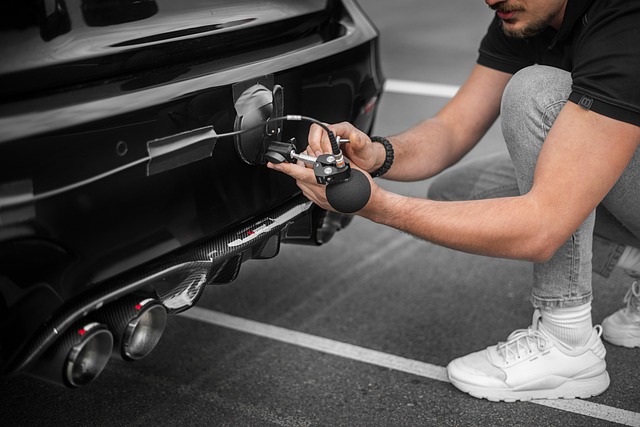Looking to register your car in California? This comprehensive guide walks you through every step, from understanding the requirements to completing the process at the DMV. First, grasp what’s needed for car registration in CA, especially the crucial role of the Vehicle Identification Number (VIN) verification. Gather all necessary documents and prepare for a detailed, step-by-step DMV VIN verification process. We’ll also share tips and considerations to make the experience smoother.
- Understand the Requirements for Car Registration in California
- Gather Necessary Documents for VIN Verification
- Perform DMV VIN Verification Step-by-Step
- Complete the Registration Process at the DMV
- Additional Tips and Considerations for Car Registration
Understand the Requirements for Car Registration in California

Before registering your car in California, it’s crucial to understand the requirements set by the Department of Motor Vehicles (DMV). The process involves several steps and documents to ensure the vehicle’s safety and identity. One key component is the DMV VIN verification, which confirms the vehicle’s unique identification number (VIN) and checks for any potential issues or recalls. This step is essential to comply with California’s strict vehicle regulations.
Additionally, you may need to undergo a mobile VIN verification process, especially if you’re registering an out-of-state vehicle or have recently purchased a car. A mobile vin inspector can provide on-site inspection and documentation, making the registration easier. The vin inspection ensures that your vehicle meets all legal standards, including emissions and safety regulations. Therefore, it’s advisable to familiarize yourself with these requirements beforehand to avoid any delays in the registration process.
Gather Necessary Documents for VIN Verification

To initiate the car registration process in California, you’ll first need to gather all the essential documents, including proof of ownership and identification. Among these, the Vehicle Identification Number (VIN) verification is a crucial step, facilitated by the DMV’s vin verification system. This process requires accurate and up-to-date information about your vehicle, so ensure you have your car’s registration papers, insurance details, and a valid driver’s license.
For added convenience, many services offer mobile vin inspection options, allowing you to complete this requirement without visiting a DMV office. These mobile vin verification services can streamline the process, making it easier for California residents to register their vehicles efficiently.
Perform DMV VIN Verification Step-by-Step

Performing a DMV VIN verification is a crucial step when registering your car in California. Here’s a step-by-step guide to ensure the process goes smoothly. First, gather all necessary documents including your vehicle registration, proof of insurance, and driver’s license. Then, visit the California DMV website to access their online services or head directly to a local DMV office.
Next, you’ll need to provide your Vehicle Identification Number (VIN). This 17-character code is unique to your car and can be found on the vehicle’s certificate of origin or on the driver’s side door frame. A mobile vin verifier or even a simple vin inspection using an online tool can help confirm the vehicle’s authenticity. Once entered, the system will cross-reference the VIN with its database to verify the vehicle’s history and ensure it meets all necessary safety standards before approving registration.
Complete the Registration Process at the DMV

After gathering all the necessary documents, it’s time to complete the registration process at your local California Department of Motor Vehicles (DMV) office. The DMV will verify crucial details about your vehicle, including a vin inspection to ensure its authenticity and history. This process often involves presenting your car’s unique Vehicle Identification Number (VIN), which can be efficiently checked through a mobile vin verification service for added convenience before visiting the DMV.
During this step, you’ll also need to provide proof of insurance, identify yourself with a valid driver’s license or state ID, and pay the required registration fees. A vin inspection ensures that your vehicle meets all safety standards and emissions regulations, confirming its eligibility for California roads.
Additional Tips and Considerations for Car Registration

When registering your car in California, there are a few extra tips and considerations to keep in mind. One crucial step is to ensure that you undergo a DMV VIN verification process. This involves checking the vehicle’s unique identification number (VIN) against the manufacturer’s records to confirm its authenticity and specifications. A valid vin inspection ensures that you’re providing accurate information, which can help prevent future issues with your registration or insurance claims.
Additionally, considering a mobile vin verification service can offer convenience and flexibility. Many companies now provide mobile vin inspection options, allowing you to complete this essential step without visiting a DMV office. This is particularly beneficial if you have a busy schedule or face challenges with transportation. By taking advantage of these modern conveniences, you streamline the registration process and ensure your car’s information is accurately recorded.
Registering a car in California involves understanding specific requirements, gathering essential documents, and successfully completing the DMV VIN verification process. By following these steps outlined in the article, including the detailed guide on performing the DMV VIN verification, you’ll be well-prepared to navigate the registration procedure smoothly. Remember to keep your documentation organized and ensure all information is accurate to avoid delays. With these tips in hand, registering your vehicle in California can be a straightforward and efficient process.



